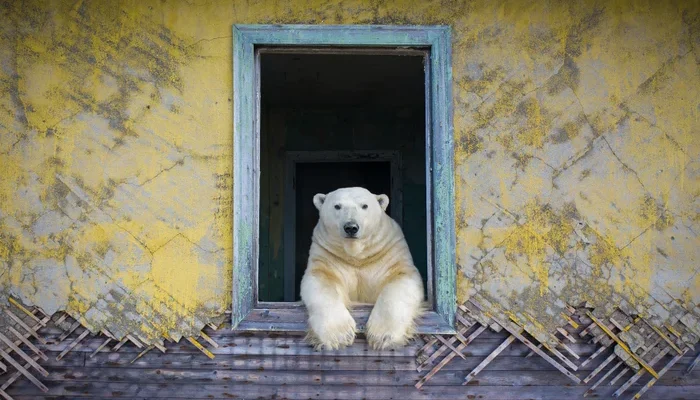In the farthest reaches of the Russian Arctic, where the wind howls across barren tundras and the sea carries secrets trapped beneath sheets of ancient ice, there lies an island—abandoned by man, reclaimed by nature, and now ruled by the last great predators of the North.
This isn’t a story about polar bears in a zoo or a documentary filmed from a safe distance. This is the real Arctic—untouched, unforgiving, and unforgettable. And what happened there in September 2021 defies everything we think we know about the wild and the world we’ve left behind.
At the heart of this story is Dmitry Kokh, a Russian underwater and wildlife photographer with a rare eye for forgotten places and fleeting moments. What he captured—photographs of polar bears wandering through the skeletal remains of a ghost town—feels less like wildlife photography and more like a glimpse into a parallel world.
A world where nature has taken back what was once hers.
An Island No One Remembers
The place is called Kolyuchin Island. It sits quietly in the Chukchi Sea, far off the beaten path, tucked in the icy grip of the Russian Arctic. Few have heard of it. Even fewer have seen it.
Years ago, it was home to a Soviet meteorological station, staffed by scientists who watched the sky, recorded the winds, and tried to make sense of the ever-changing Arctic weather. But when the Cold War cooled and the logistics grew too brutal, humans left. And the island was abandoned—left to rust and rot, a collection of skeletonized buildings battered by snow, ice, and time.
Until 2021, that is, when the island’s silence was interrupted—not by the return of people, but by something else entirely.
The Search for the Bears Begins Elsewhere
Kokh hadn’t originally planned to visit Kolyuchin. His journey began with a far more predictable destination: Wrangel Island, a UNESCO World Heritage Site famous for its dense population of polar bears. It was here, Kokh believed, that he’d capture the images he came for.
Along with his team, Kokh sailed 1,200 miles along the desolate, icy coastline of the Russian Arctic—a voyage through one of the most inaccessible and unspoiled regions on Earth. Their boat bobbed through freezing waters, their eyes trained on the horizon for any sign of movement.
But Wrangel Island let them down.
For reasons still unknown—perhaps shifting ice, perhaps climate patterns, perhaps something else—the bears were gone. And so was Kokh’s hope. His expedition teetered on the edge of disappointment.
But fate had other plans.
Ghosts in the Windows
As the boat drifted past Kolyuchin Island, the crew didn’t expect much. Maybe a few photos of the crumbling station, wind-whipped buildings silhouetted against the gray Arctic sky. But then someone noticed it—a flicker of movement.
In the windows of the decaying outpost, something shifted.
They slowed the boat. Raised binoculars. And what they saw felt impossible: polar bears, peering out from the broken windows like sentinels of another world.
No one had ever seen bears behave like this. They weren’t wandering the tundra or hunting on the ice. They were inside the buildings, lounging in former offices, poking their heads out like curious tenants.
It was a scene that belonged to no known reality—nature wearing the ruins of civilization like a mask.
And Kokh knew he had one chance to capture it.
The Photos the World Would Never Forget
With a drone carefully launched into the still air, Kokh maneuvered his camera over the desolate landscape. What he captured defies belief.
The photos show polar bears reclining in shattered windows, stepping through doorways covered in rust, framed by collapsing walls and peeling Soviet paint. In one haunting image, a massive bear gazes directly into the lens from the second floor of an abandoned building, as though it knows it’s being watched—and doesn’t care.
There are photos of mother bears with cubs, their white fur a stark contrast to the rusted metal and cracked concrete. In others, the bears feed, nap, or stare silently out to sea, lords of a kingdom man forgot.
And in every shot, the emotion is undeniable: melancholy, wonder, power.
These are not animals in a zoo, nor are they textbook specimens of polar biology. These bears are something else—ghosts inhabiting the ruins of our ambition.
A Place That Doesn’t Feel Real
When Kokh shared the photos, the internet erupted. They went viral, passed around like glimpses of a dream, or evidence from another dimension.
Some asked: Why are the bears there? Experts believe the buildings offer temporary shelter—especially for females and cubs—providing respite from wind and predators. Others suggest the buildings may serve as convenient watchpoints while waiting for the sea ice to return.
But no one knows for certain. Because Kolyuchin Island is not monitored. It is too remote, too harsh. Too forgotten.
The buildings, once filled with data and maps and men chasing clouds, now serve as dens. The architecture of progress has become the architecture of survival.
And it’s hard not to feel that something larger is being revealed.
Nature Reclaims What We Leave Behind
There is a haunting beauty in Kokh’s photos, not just because of the bears, but because of what they represent.
We built these places. We filled them with machines, technology, purpose. And then we left.
And the wild returned—not with violence, but with quiet, icy patience.
There’s something deeply symbolic about polar bears living inside human buildings. It’s as if nature, long denied, has finally entered the house.
What does it say about us, that we built a station here to study the sky… and now the only things left watching the heavens are creatures we once considered beneath us?
The Disappearing North
Climate change has made polar bears a tragic symbol. As the ice melts and their territory shrinks, they’re being pushed farther and farther from their traditional hunting grounds. Some starve. Others adapt.
And some, like those on Kolyuchin Island, find strange new homes in the wreckage of man.
The Arctic is changing. The polar regions are warming faster than any place on Earth. In a few decades, the sea ice may disappear entirely during the summer months.
What then? Will the bears become ghosts of a forgotten world, remembered only in images like Kokh’s?
Or will they outlive us all, inheriting the ruins we left behind?
The Magic of Isolation
Kolyuchin Island is not the only place like this. All over the world, we’re seeing examples of nature moving back into abandoned human spaces:
- Wild boars in Fukushima, wandering through radioactive ghost towns.
- Leopards stalking the empty halls of shuttered temples in India.
- Birds nesting in forgotten factories, vines curling around forgotten machines.
These places are not just ecological footnotes. They are windows into a future where the balance of power has shifted, where nature is no longer something to be conquered, but something that silently waits for us to disappear.
The Photographer Who Became a Witness
Kokh didn’t just take pictures. He bore witness.
In that moment—drifting off the coast of a forgotten island, staring through the eye of a drone at a polar bear standing in a window—he captured something profound:
The end of an era. The beginning of another.
His photos are more than just beautiful. They’re evidence. Testimony. A visual prophecy that whispers: This world isn’t yours alone.
The Island Still Stands
Today, Kolyuchin Island is still there. The buildings are still crumbling. The bears, as far as we know, still live there.
No tourists come. No signs point the way. There are no gift shops, no plaques, no guards.
Just wind. Ice. Silence.
And the bears—living where we once lived, sleeping where we once studied, surviving in the ghost of our ambition.
So if you ever find yourself wondering what happens when we leave, remember this:
Sometimes, nature doesn’t just return.
Sometimes, she moves in.

